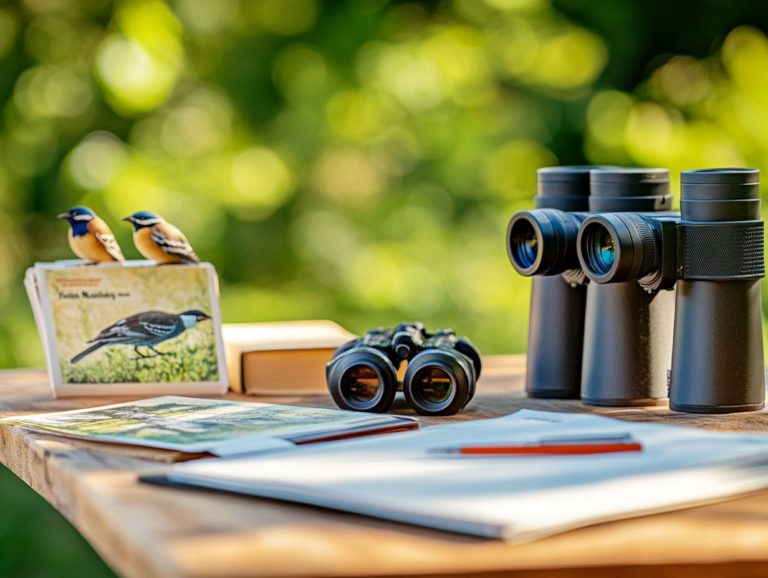Field Guide Myths: Debunking Common Misconceptions
Field guides are treasures for anyone captivated by the natural world, yet they come wrapped in a shroud of misconceptions.
You might think they re reserved for seasoned experts or assume that every guide presents the same information. Such myths can deter both beginners and enthusiasts from fully embracing these resources.
Get ready to uncover five common myths about field guides that could change how you explore nature! This article aims to dismantle these myths, showcasing the accessibility, relevance, and diverse applications of field guides.
Explore how these invaluable tools can deepen your connection to nature today, no matter your level of experience.
Contents
Key Takeaways:

- Field guides can empower beginners, not just experts!
- Field guides may seem outdated, but they are accurate and regularly updated.
- While identifying species is a common use for field guides, they also have other important uses.
Defining and Identifying Field Guide Myths
Field guides are often misunderstood. Many enthusiastic novices and students are unaware of their true potential.
Myths surrounding their use can mislead those who could truly benefit from these invaluable learning tools, ultimately stifling the learning process and inhibiting learning.
This article sets out to debunk these myths by illuminating the diverse applications of field guides across various disciplines, including medical education, the humanities, and social sciences.
By fostering a community of researchers dedicated to accurate information and effective teaching strategies, you can significantly enhance educational practices and outcomes for all learners.
One prevalent misconception is that field guides are merely reference materials intended for professionals. This overlooks their capacity as engaging tools that can ignite curiosity and drive critical inquiry among students.
Many educators might underestimate how precise field guides can bolster engagement in educational psychology by offering tangible examples that encourage hands-on learning and exploration.
When woven into instructional strategies, these guides can inspire learners to ask questions, delve into the subtleties of their subjects, and connect theoretical concepts to real-world scenarios.
Ultimately, this enriches the educational experience and deepens their understanding of the material.
Myth #1: Field Guides are Only for Experts
The notion that field guides are solely for experts is a common misconception that often deters beginners from tapping into the wealth of insights these resources can provide.
It s easy to see why many students and novice researchers might feel daunted, believing they lack the essential knowledge and research skills to make effective use of these guides.
Yet, field guides can serve as a vital bridge in your understanding, offering foundational knowledge that enriches your learning experience, fosters deeper engagement, and encourages collaboration with mentors and peers.
Debunking the Myth and Encouraging Beginners
To debunk the myth that field guides are just for experts, it’s essential to highlight how they can enhance your engagement and nurture a passion for exploration, especially if you’re just starting out. Field guides serve as a gateway to building your knowledge, enabling you to navigate complex topics with confidence and curiosity.
By embracing teaching methods backed by research, educators can inspire you to use these guides to dispel misconceptions and truly appreciate the value of scholarly activities throughout your learning journey.
Integrating field guides into your educational experience can be both exciting and practical. Think about hands-on activities like field studies and nature walks, where you can apply what you’ve learned in real-world scenarios. Imagine the thrill of your biology class exploring a local habitat with a field guide in hand to identify various plants and animals. This could culminate in a presentation project that showcases your findings.
Using field guides in project-based learning allows you to create your own guides based on research, solidifying your understanding while igniting your creativity. Successful initiatives, like a community garden project where you document plant growth and variation using these guides, illustrate the significant impact these resources can have on developing your critical thinking skills and fostering collaborative inquiry.
Myth #2: Field Guides are Outdated

Contrary to what many might think, field guides are far from outdated; they are, in fact, living documents that evolve with the latest scientific knowledge and practices.
Ongoing research in educational psychology and interdisciplinary studies keeps these guides not just relevant, but also precise. This effectively dispels the myth surrounding their credibility. Scholars continuously update the content, which significantly enhances the reliability of information that educators and students can trust when using field guides in diverse educational settings.
Exploring the Accuracy of Field Guides
Field guides are crucial for effective navigation of your subject matter! These guides draw on insights from scholars and researchers, evolving with new scientific findings to enhance your learning outcomes. Their ability to adapt helps dispel common myths and reinforces their value as essential resources for both students and educators.
This integration of expert insights refines and evolves the content, ensuring it remains relevant and practical across various learning environments. By breaking down complex scientific concepts into accessible language and relatable examples, these guides significantly elevate your educational experience.
They do more than serve as reference materials; they’re game-changers for fostering critical thinking and inquiry-based learning. Continuous collaboration with subject matter experts guarantees that you receive the most accurate, up-to-date information, ultimately deepening your understanding and nurturing a lifelong passion for discovery.
Myth #3: Field Guides are Only for Identifying Species
You might think that field guides are just handy tools for identifying species, but that s a narrow view of their true potential. While identification is certainly important, these guides go far beyond that; they enrich educational practices and support interdisciplinary research.
These guides provide context, background information, and practical applications across various fields. By underestimating their value, you risk overlooking how field guides foster a vibrant community of researchers who utilize them for inquiry and exploration, extending well beyond simple identification.
Uncovering the Other Uses of Field Guides
Uncovering the various uses of field guides reveals their potential to enhance critical inquiry and broaden your learning experiences.
Beyond simply identifying species, these guides are invaluable tools for bringing people from different fields together. They enrich educational practices across various disciplines.
By integrating field guides into your curriculum, you can inspire learners to delve into complex subjects. This encourages them to engage in critical thinking and take an active role in their educational journey.
For example, in a biology class, you might have students work in teams to conduct field research. They can use guides to identify various plants and animals while honing their observational skills (the ability to notice and interpret details). This hands-on approach deepens knowledge and sparks exciting conversations among students!
Similarly, in environmental studies, students could embark on community projects that involve assessing local ecosystems. Using field guides to document biodiversity (the variety of plant and animal life in a particular habitat) fosters a sense of stewardship.
Such collaborative projects cultivate inquiry skills and deepen students appreciation for the interconnectedness of natural systems, promoting a holistic approach to learning.
Myth #4: Field Guides are Only for Nature Enthusiasts

The idea that field guides are exclusively for nature enthusiasts is a limiting misconception. It overlooks their broader educational value.
In truth, field guides can cater to a wide range of audiences, including students in the humanities, social sciences, and beyond.
By embracing diverse educational perspectives, field guides can also foster collaboration among different disciplines. This enriches the learning experience for everyone involved and promotes an inclusive approach to knowledge adaptation.
Expanding the Audience for Field Guides
Expanding your audience for field guides is essential for promoting interdisciplinary research. It elevates educational practices across various fields.
By nurturing a community of researchers who engage with these guides, you can harness the knowledge explosion happening across disciplines. This leads to richer educational experiences.
This shift dispels the notion that field guides are solely for nature enthusiasts and showcases their value in diverse contexts, including medical education and social sciences.
Encouraging collaboration among experts from different fields can illuminate the multifaceted applications of these resources. For example, a recent project that merged environmental science with urban planning demonstrated how field guides could play a vital role in designing sustainable cities by providing crucial data on local flora and fauna.
Health professionals are now using field guides to gain insight into community health patterns. By highlighting these successful initiatives, you can inspire broader adoption and adaptation of field guides, ultimately bridging knowledge gaps and enriching the research toolbox for academics and practitioners alike.
Myth #5: Field Guides are All the Same
The notion that all field guides are identical is a misconception. It diminishes the richness and unique contributions each guide offers in educational research.
Each field guide is meticulously crafted for specific subjects, contexts, and audiences. They embody a range of teaching strategies, methodologies, and educational objectives.
By recognizing these distinctions, you can choose the most suitable guides that align with your students existing knowledge. This significantly enhances their overall learning experience.
Explore the diverse uses of field guides today and enhance your learning experiences!
Comparing and Contrasting Different Field Guides
Comparing and contrasting different field guides helps you, whether as an educator or student, identify unique features that cater to your learning needs. Understanding the differences between these guides enhances how effectively you can use them.
When you carefully evaluate different guides, you can choose those that fit your teaching strategies and address the various needs of your students.
For example, a field guide that emphasizes hands-on activities may resonate more with young learners. In contrast, a comprehensive guide filled with complex terminology might be better suited for advanced students delving into specialized subjects.
Guides featuring detailed illustrations and engaging visuals significantly enhance understanding and retention, especially in environments where visual learning is essential.
Guides with detailed lists and cross-references help you navigate specific topics easily, fostering valuable independent research skills. By recognizing these varying features, you can make informed decisions that support your curriculum and enrich the educational journey for all your students.
Frequently Asked Questions

What are some common misconceptions about field guides?
Some believe field guides only provide information about plants or that they are only useful for experienced outdoor enthusiasts.
Are field guides only useful for identifying plants?
No, field guides can help identify animals, rocks, minerals, and other natural objects. They also provide information on habitats, behaviors, and intriguing facts.
Do I need to be an expert to use a field guide?
No, field guides are made for all experience levels. They’re an excellent tool for beginners to explore the natural world and can also offer new insights for experienced individuals.
Do field guides only contain information about local species?
No, many field guides cover species from various regions. While some may focus on a specific area, others encompass a broader range of species.
Are all field guides the same?
No, numerous types of field guides exist. Some focus on specific species, like birds or wildflowers, while others cover a variety. It’s vital to choose a guide that fits your specific needs.
Can I rely on a field guide for accurate information?
Field guides are valuable resources for learning about plants and animals. However, it’s crucial to cross-reference information and verify it with other sources, as they may contain outdated details.






